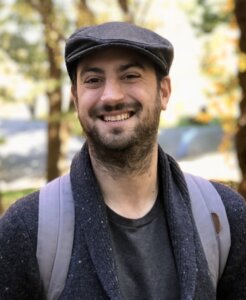A small town in Spain is finally embracing its Jewish history — but is any of that history true?
In Hervás, a rural hamlet of 4,000, an invented Jewish heritage has become a point of pride and a marketing tool
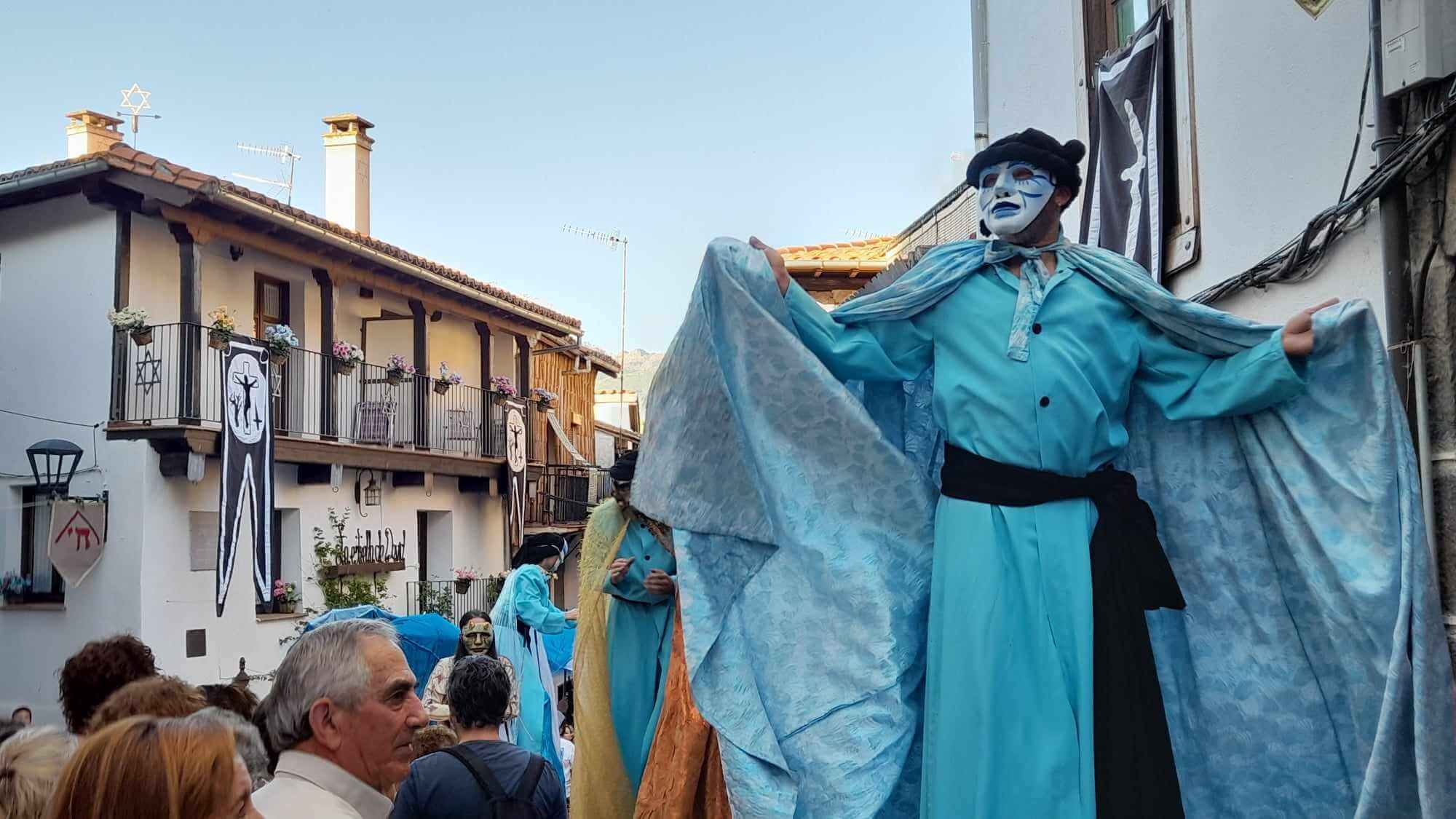
The Grand Traditional and Artisanal Market during the Festival de los Conversos. Photo by Maria Montserrat
HERVÁS, SPAIN — A gray-bearded shopkeeper in a white yarmulke and long robe sells menorahs, Stars of David, and Kabbalist medallions. Outside of his shop, the maze of narrow medieval streets is lined with artisans; men wear skullcaps and women wear head coverings.
But alongside the Judaica, there are Virgin Marys and crosses, and the outfits are just costumes. This is modern-day Spain on a Saturday morning.
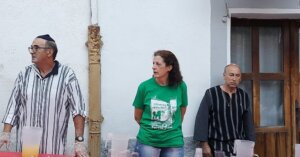
The occasion was the Festival of the Conversos, an annual weekend event held in Hervás, a village in the region of Extremadura famous for its well-preserved 13th-century Jewish Quarter. Since 1996, the village has attracted tourists promising to celebrate “the coexistence of Jews and Christians, and its legacy till today through theater, music, and food.”
“I’m baptized,” the shopkeeper Pedro Ángel Gil Moreno told me. “I’m Christian.” But he added that, like many in Hervás, he descends from conversos, Jews who were forced to convert to Christianity during the Spanish Inquisition and practiced Judaism secretly. Each year, for the festival’s market, he and others dress up as 15th-century Jews by wearing North African djellabas.
Until 12 years ago, Gil Moreno, 63, was a truck driver. As the agriculture, lumber, and textile industries have floundered in Spain’s poorest region, many in this working-class neighborhood have embraced the area’s Jewish roots.
He turned his family home into a small hotel, “Apartamentos Estrella David,” with the “Shalom Alecheim” gift shop downstairs, which is spelled correctly in Hebrew, but wrong in Spanish. It’s located on Calle de la Amistad Judeo-Cristiana, or Jewish-Christian Friendship Street.
The residents of Hervás have based their economy — and to an extent their identity — on their Jewish past. However, much of this history appears to be untrue — and they know it.
Heirs to Sepharad
I came to the festival in Hervás, a rural hamlet of 4,000, and stayed in the Hotel Spa Sinagoga, which, aside from its name, is in no way Jewish. I was eager to see the community play, which is performed each year along the rocky Ambroz River at the bottom of the Jewish Quarter. The set spans both sides of the river and includes a floating stage. The neighborhood’s 13th-century brick and adobe buildings serve as a backdrop for townspeople, from school children to retirees, who wear elaborate costumes and perform plays about the Inquisition in Hervás. This year’s play, Pacto entre Damas (“A Ladies’ Agreement”), started, in Spanish fashion, at 11 p.m. each night over four days.
I was also intrigued by the prospect of seeing Spaniards carousing and eating jamón (a type of ham) while dressed as religious Jews. The market, the biggest event of the festival, however, felt more familiar than shocking. I had been to medieval markets in Spain before. Vendors sell handmade goods and offer local honey, wine, cheeses, and cured meats. Roving bands play folkloric music, and residents wear traditional regional outfits — though that usually means crosses, not six-sided stars.

Some festivals commemorate a local Middle Ages event like Cervantes’ baptism, but they tend to be lighthearted and not historically rigorous. Still, how Spaniards interpret their medieval past reflects how they see themselves today.
Outside of Toledo, the theme park Puy du Fou España is operated by a conservative French group whose original park in the Loire region of France welcomes over 2 million visitors each year. On elaborate sets, 300 actors, dancers, falconers, and jockeys reenact scenes of Spanish Christians defeating the Moors and discovering America, but leave out Spanish Jews.
While the right is nostalgic for an ascendant Catholic Spanish empire, liberals prefer to view medieval Spain as a model of coexistence between Christians, Muslims and Jews. This celebration of the “three cultures,” while still glossing over the pre-Inquisition violence, appeals to a Spanish society that transitioned from a Catholic dictatorship to a multicultural democracy in the last quarter of the 20th century.
According to Hispanists Daniela Flesler and Adrián Pérez Melgosa, who co-wrote the 2020 book The Memory Work of Jewish Spain, there was a surge of interest in Sepharad, the Ladino name for the Iberian Peninsula, in the early ’90s, following the 500th anniversary of the expulsion of Jews.
“Communities throughout the country,” Flesler and Melgosa wrote, “reclaim their status as heirs to Sepharad in an effort to showcase their full belonging to modernity and Western Europe.”
These communities also found that their Jewish roots could pull in tourist pesetas.
Was there ever a Jewish ghetto here?
Hervás was a trailblazer, having marketed its Jewish quarter as early as the 1960s, when the Spanish Ministry of Culture declared it a Historic-Artistic Site. In 1995, it co-founded, along with four Spanish localities including Toledo and Córdoba, the Network of Jewish Quarters of Spain (La Red de Juderías) which promotes Jewish tourism in Spain. Other towns and small cities followed suit, leaning into their Jewish history in hopes of luring tourists away from Spain’s beaches. The Network of Jewish Quarters of Spain now has 20 member localities.
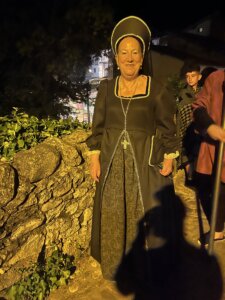
Resurfacing Sephardic roots can prove challenging after centuries of meticulously and violently erasing Jewish heritage. Less than 0.1% of Spaniards today are Jewish. The country boasts Paleolithic cave paintings, Moorish palaces, and pre-Roman ruins, but even though it was once home to the world’s largest Jewish community, only four medieval synagogues survive, having been converted to churches. Museums are replete with Roman relics, but the national Jewish museum in Toledo exhibits mostly modern Sephardic objects.
“It’s an invisible heritage,” said Rebeca Farran, a tour guide who works for the tourism office of Hervás. On her tours, she explains kashrut rules and uncovers the Jewish influence in the Spanish region, known for its high-quality pigs. Some examples sound reasonable. Floretas, a fried flower-shaped pastry, she said, is a descendant of a Hanukkah dessert; and nuegado, a nut, honey, and orange Christmas treat, is a Jewish recipe passed down by grandmothers. Other examples seem more far-fetched. That Spaniards wash their hands before meals, she says, is “very Hebrew.”
On Farran’s tour, she shows where the synagogue once stood on Calle Rabilero, and how conversos later secretly prayed in the rabbi’s home next door. The street name, she says, is a bastardization of rabino, Spanish for “rabbi.” Standing on the narrow crooked street or on nearby Calle Sinagoga with its centuries-old homes decorated with chais and menorahs, you can “feel the history” like the online travel guides say.
But according to local historian Marciano Manuel Martín, it’s not true.
In his 2023 book Jews, Laborers, and Merchants of Hervás, he writes that there is no evidence of a synagogue on Calle Rabilero or that the street’s name was Jewish in origin.

The village never had a Jewish ghetto. Historical records show only a small number of Jewish families who lived in Hervás for less than a century, not in the lower area, now known as the Jewish Quarter, but in the upper modernized neighborhood, thought of as the Christian section. Like Calle Rabilero, there is no documented evidence of a Calle Sinagogoa before the 17th century, long after the expulsion.
“I don’t know why he says these things,” said Farran when I asked about Marciano. “We all make our living off of this.” When she first started giving tours 10 years ago, the researcher and writer would trail her groups and heckle.
I asked who she thought was more reliable. “That’s the thing, he is the best source,” she responded.
Marciano, 67, was once the Jewish Quarter’s biggest booster. In a 1992 Israeli documentary about the visit of Israel’s first Sephardic president, Yitzhak Navon, to Spain, he is seen giving the foreign dignitary a tour of Calle Rabilero. He was the go-to guide for the tourism office, and is still cited in the official guides of Hervás. In 1983, he published a book, The Jewish Quarter, which developed the narrative still repeated today. But in 1997 he recanted much of it in an academic article titled “The Invention of a Tradition: apocryphal legends of Jews in Hervas.” Since then, his research has chipped away at the official story.
Marciano’s wife owns a gift shop in the Jewish Quarter. Everyone seems to know him, but they pay little mind to his research.
“We know Jews lived in Hervás,” a bookshop owner who sold me Marciano’s book told me with a shrug, “and Hervás has a beautifully preserved medieval section.” The village was honoring its Jewish history, she argued, and if the details were wrong, that was of little consequence.
How antisemitism became philosemitism
I found Marciano, who has a gray beard and was wearing a straw hat, outside the Jewish Quarter, away from the market, selling used books to support the Hervás Feline Association. We chatted, but he refused an interview because of “media bias” in coverage of Jewish tourism in Hervás. The topic made him visibly agitated.
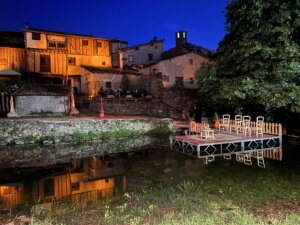
Marciano in his articles and books painstakingly shows how Hervás repressed its Jewish history and then “covered the memory gaps with the invention of a Jewish tradition.” In 1887, A. Manzano Calzado, a school teacher, laid the seeds for this invention. He wrongly speculated that the street name Sinoga (now Sinagoga) denoted the location of a synagogue and wrote that a local saying, “In Hervás, mostly Jews” (En Hervás, judíos los más), was proof of a large Jewish community. Marciano explains that the phrase, still commonly repeated, uses “Jew” to mean “greedy.”
In subsequent decades, local writers embellished the myth of how the lower neighborhood, a slum where many houses still lacked running water in the 1970s, preserved its Jewish character over the centuries.
Today, travel bloggers describe a Hervás alley just a half-meter wide as an example of “Jewish architecture.” A century ago, writers and researchers visiting Hervás projected Jewish influences in the cuisine and local traditions, like throwing bread during weddings. A children’s game was said to have hidden references to the murder of Christ. And after the Spanish Civil War, the fact that the neighborhood sided with the Republicans against the fascists was seen as anti-Christian and disloyal — evidence of its Jewish-ness. Eventually, the mark of shame on the lower half of the village became a selling point. All 17 streets of the medieval area became known as the Jewish Quarter.
But without questioning its history of antisemitism, old stereotypes are inevitably upheld. Or as Maricano puts it, “Historic antisemitism has evolved into philosemitic tourism.”
‘The people of Hervás only use the Jewish Quarter for economic gain’
This year’s play was about a Jewish woman who hatches a plan with a coldhearted Duchess to save her son from the Inquisition. The Jewish characters come across sympathetically, but each one is a wealthy landowner or a savvy moneylender. Likewise, the city of Zaragoza sets out to celebrate tolerance in its Three Cultures Medieval Market, but falls short with its coin-minting workshop, which is meant to represent Jews.
For many Spaniards, Jews are synonymous with wealth. In 2014, Forward writer Josh Nathan-Kazis reported that a tourism official in the town of Lucena sought to boost the town’s Sephardic connections based on “something vaguely antisemitic about Jewish money.”
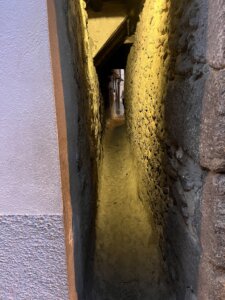
“The people of Hervás only use the Jewish Quarter for economic gain,” said Abigail Cohen, an Israeli who grew up on a kibbutz and for 15 years was the only Jew in Hervás’ Jewish Quarter. “They’re not interested in anything Jewish.”
Cohen spoke to me by phone from outside Toledo, where she sells pastries based on recipes from her Syrian Jewish grandmother. Until 2019, she ran a Sephardic restaurant, pastry shop, and bed-and-breakfast in Hervás. She’s fine with locals profiting from Spain’s Jewish heritage, she says, but feels it is disrespectful for Spaniards to wear yarmulkes while eating ham tapas on Shabbat.
She wishes Spanish people had a more meaningful interest in Jewish culture. “They do a lot connected to the three cultures,” she said, “but based on their own interpretation.”
Since Oct. 7, she says, her pastry sales have fallen. During the Second Intifada, anti-Israel protests in Hervás made her feel so uncomfortable that she stayed home for a few days. At the time, the village quietly removed a plaque denoting “Plaza del Estado de Israel.” It’s the only time she felt unwelcome in the village.
Israel is the prism through which most Spaniards view modern Jews. Farran starts her tours with the disclaimer that she discusses Jews in Hervás in the Middle Ages, not “current conflicts.”
“When talking about the medieval Jewish community, people feel a degree of pity,” Farran said, “but if the subject changes to the current conflict, they change their tune, saying Jews are bad.”
Cohen believes that a community with a “Jewish-Christian Friendship” street should be more sympathetic to Israel. But the fascination with 15th-century Jews feels disconnected from present-day Jews. Discussing Israel-Palestine with participants of the Festival of the Conversos feels like asking the Broadway cast of Aladdin their take on Middle East politics.
Flesler and Pérez Melgosa, who write about Hervás, warn against viewing Jewish tourism in Spain as purely opportunistic cultural appropriation. “Once set in motion, the renewed, broad public attention to Spain’s Jewish heritage,” they say, “has also brought to the fore personal and community stories, affects, and aspirations, unleashing a series of unexpected consequences.”
Hervás’ promotion of its Jewish heritage led Marciano to deeply study local and Jewish history. Cohen also praises a local music group, La Karamba, that performs authentic Sephardic music, albeit in Jewish costumes. Farran says that locals have become more culturally sensitive. At this year’s festival, the tourism office did not display large stereotypical Jewish mannequins as they had in the past, and community actors did not speak fake Hebrew in their play.
More fundamentally, Flesler and Pérez Melgosa write that as Spanish localities create Jewish spaces and celebrate Sephrarad, locals have started to see themselves differently.
A tradition, lost and found
“I’m Jewish,” Eladia Valle, a 95-year-old woman who grew up in the Jewish Quarter, told me. Her son suggested her great-great-great grandparents might have been conversos, but by identifying as Jewish, she was expressing a sense of pride in being from her working-class neighborhood, the Jewish Quarter.
“Jewish,” long a slur hurled at her poorer community, had, in recent decades, taken on a positive connotation. The neglected slum was now the pride of the village. To be Jewish had cachet. Neighbors decorated their homes with Stars of David.
“My grandfather was Jewish,” Gil Moreno told me from inside his shop, “but we lost our traditions.” He was surrounded by knicknacks with Jewish symbols and a Spanish translation of the Torah. His livelihood was based on the neighborhood’s Jewish identity, even if it wasn’t true. I asked him how it was working out.
“You can’t get rich off of it,” he responded.
